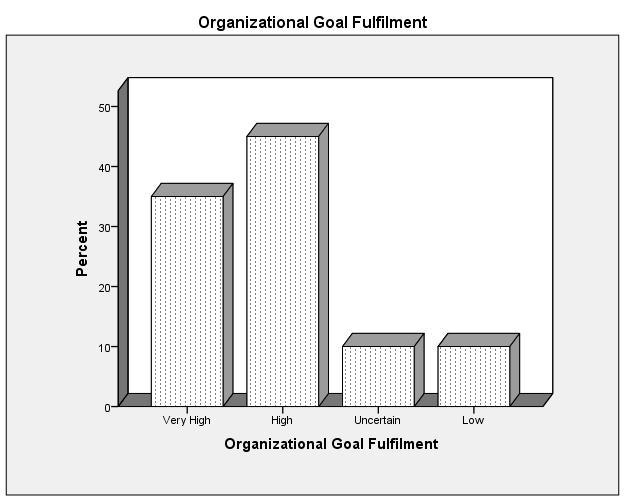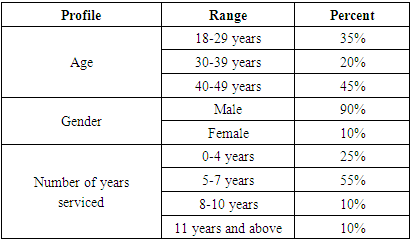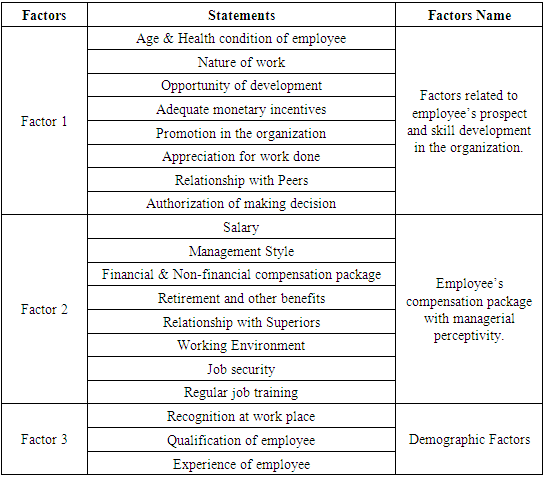-
Paper Information
- Paper Submission
-
Journal Information
- About This Journal
- Editorial Board
- Current Issue
- Archive
- Author Guidelines
- Contact Us
Human Resource Management Research
p-ISSN: 2169-9607 e-ISSN: 2169-9666
2022; 12(1): 1-5
doi:10.5923/j.hrmr.20221201.01
Received: May 26, 2022; Accepted: Jun. 10, 2022; Published: Jun. 23, 2022

Factor Analysis: The Outcome of Motivation on Employees’ Performance in Textile Sector
Sraboni Ahmed1, Mohammad Shayekh Munir2, Mohammad Rashel Hawlader1, G. M. Faysal1, Md. Nazmul Islam1
1Department of Textile Engineering, Northern University Bangladesh, Dhaka, Bangladesh
2Department of Textile Engineering Management, Bangladesh University of Textiles, Dhaka, Bangladesh
Correspondence to: Sraboni Ahmed, Department of Textile Engineering, Northern University Bangladesh, Dhaka, Bangladesh.
| Email: |  |
Copyright © 2022 The Author(s). Published by Scientific & Academic Publishing.
This work is licensed under the Creative Commons Attribution International License (CC BY).
http://creativecommons.org/licenses/by/4.0/

Every organization's employees play a critical part in its success. People are motivated by something that drives them to act and keeps them dedicated to the project they started. It has to create and increase every employee's desire to work successfully and efficiently in his or her role. The following research is a self-conducted investigation of the factors that influence employee performance to improve it. For this study, a descriptive design was used, and the survey questionnaire had 31 items that were constructed using a Likert Scale and dichotomous responses. A convenience probability sampling strategy was utilized to select 20 employees from five textile and garment industries at Dhaka and Gazipur in Bangladesh. SPSS was used to do factor analysis on the data collected. The most intriguing part of this study is that it discovered that all of the factors investigated have a substantial association with motivation.
Keywords: Employee, Job Enrichment, Job satisfaction, Compensation, Motivation
Cite this paper: Sraboni Ahmed, Mohammad Shayekh Munir, Mohammad Rashel Hawlader, G. M. Faysal, Md. Nazmul Islam, Factor Analysis: The Outcome of Motivation on Employees’ Performance in Textile Sector, Human Resource Management Research, Vol. 12 No. 1, 2022, pp. 1-5. doi: 10.5923/j.hrmr.20221201.01.
Article Outline
1. Introduction
- In today's fast-paced businesses, motivated professionals are essential. Employees that are motivated help businesses survive. Inspired employees usually work harder [1]. Management must know what motivates people in the context of their jobs to be effective.Motivating staff is undoubtedly the most difficult of all the tasks a manager must perform. This is partly due to the fact that employee motivation is continuously changing. [2]. Motivation is related to an organism's readiness to achieve a specific goal, and it entails determining the type and location of the variables that cause this readiness. It's a procedure in which people's needs drive them to act in ways that satisfies their requirements. [3] [4].Bangladesh's textile sector is labor-intensive. As a result, the sector's financial success is largely determined by the performance of its personnel. Workers in Bangladesh's garment sector are currently less motivated and fulfilled in their everyday duties, and factory owners appear to be unconcerned about their employees' motivation. If enough focus is not paid to this long-standing problem in the textile industry, it is expected to persist in the future. The study investigates the impact of employee motivation on textile industry performance. It was driven by the survey's focus on employee motivation at a medium level. In today's continuously changing businesses, motivated employees are essential.Since Bangladesh is still a developing nation, it is critical that our economy is well-managed and that we can put forth our best effort in the workplace. As a result, we need to know where we stand in terms of personnel inspiration and what else we can do to make sure more effective operation from our people employed. It's also necessary to understand employee behavior and expectations so that upper management may provide them with more and more benefits. This will prove helpful for scholars and give data for future research.
1.1. Objective of the Study
- The study's overall goal is to examine the motivational elements that influence employee performance in the textile industry, with the following specific goals:1. To determine the elements that drive employees.2. To discover elements that lead to employee unhappiness.3. To assess the productivity of staff.4. To estimate the impact of employee motivation on their productivity.
1.2. Research Questions
- This section is concerned with the design of the research question that will aid in the achievement of the study's objectives. The questions are:1. What variables inspire employees in the textile industry?2. What are the variables that cause staff turnover?3. What factors influence employee success in the textile industry?4. In the textile industry, what impact does motivation have on organizational effectiveness?5. What are some ways that the textile industry could enhance motivation?
2. Literature Review
- Professional motivation is a key factor (or a group of characteristics) that encourages employees to complete tasks or meet goals. It's what inspires people to behave in various ways. Extrinsic and intrinsic motivation are the two most common incentive theories used by employers [5]. External pressures such as extrinsic motivations inspire an employee to finish a task or achieve a goal. Typically, they are either penalties or incentives. A reward drives an employee to behave to get the bonus, whereas a punishment stimulates an employee to behave to prevent the penalty. Extrinsic incentives are easier to remember because they come from outside factors.Self-motivation, on the other hand, is intrinsic motivation. When the task itself motivates an employee, he is organically motivated to work. He might enjoy the work or find it satisfying. The motivation comes from the work itself. Because it comes from within the individual rather than being pushed on them, intrinsic motivation is typically more successful than extrinsic motivation. Because intrinsic motivation comes from within the employee, it's simple to recall.Following the release of the Hawthorne Study results, several researchers focused on determining what inspired employees and how they are being motivated [6]. Five significant ideas that have influenced our knowledge of motivation include Skinner's reinforcement theory, Herzberg's two-factor theory, Adams' equity theory, Maslow's need-hierarchy theory and Vroom's expectancy theory.Maslow proposed five categories of needs: physical, security, interpersonal, self-importance, and personality [7]. He claimed that workers needed to be motivated by lower-level expectations before higher-level demands could be met. Motivators and hygienes were divided into two categories by Herzberg [8]. Job happiness is influenced by motivators or intrinsic variables such as accomplishment and appreciation. Work unhappiness is caused by hygiene or external factors such as income and job stability.According to Vroom's idea [9], employee effort will lead to positive results, and success will lead to incentives. Positive or negative consequences are possible. The more positive the incentive, the more motivated the employee will be. In contrast, the employee is less likely to be motivated if the benefit is unfavorable.Employees seek for equality among themselves and other co-workers, according to Adams' idea. When the ratio of employee outputs to inputs is comparable to other employee outcomes to inputs, equity is attained. [10].Skinner's hypothesis basically asserts that employees will repeat actions that result in positive outcomes and will not repeat behaviours that result in bad outcomes [11]. Employee activities that contribute to favourable outcomes should be favourably reinforced by managers. Employee behaviour that leads to undesirable outcomes should be adversely reinforced by managers.
3. Research Methodology
3.1. Research Design
- The complete survey was chosen based on the study's purpose, research questions, and estimated population size. The purpose of descriptive surveys was to acquire detailed information on a well-known occurrence.
3.2. Secondary Data Collection
- Data already published in books, newspapers, magazines, journals, online portals, company reports etc. was taken as Secondary data was discussed in greater depth in Literature Review section.
3.3. Primary Data Collection
- To collect data for the study, a survey questionnaire was created.
3.4. Study Place
- Data of the target population was obtained from five groups of companies located at Dhaka, Gazipur and Savar: Al-Muslim, FCI, Hams, Windy and Ananta Group.
3.5. Sample Size
- The sample for this research included the 20 employees of different factories.
3.6. Sample Technique
- Convenience sampling was used for this study.
3.7. Data Management Tools
- The survey included of closed-ended questions, with the majority of them using a Likert scale. The results are evaluated using a frequency distribution and a bar chart.
3.8. Data Analysis
- Statistical Package for Social Science (SPSS) - Software version 21 was used to analyze the data for this study.
4. Results & Discussion
4.1. Respondents' Profiles
4.2. Test of Factor Analysis
- The primary goal of a factor analysis test is to identify representative factors from a large number of variables.
|
|
4.3. Inferences
- Here in the rotated component matrix, researchers can find variables and their correlations with extracted three factors. Here there are three reduced factors that got by Factor Analysis Test.
|
4.4. Descriptive Statistics Analysis
- Employees believe that the nature of their work and advancement within the firm have a significant impact on their performance, according to the survey. This implies that an organization must ensure that individuals who already have performed continuously are promoted fairly within the firm. Another research demonstrates that promotion opportunities and a sense of responsibility have an influence on productivity. Employees' performance is influenced by whether they are appreciated for their work, their remuneration, their working circumstances, how well their leaders interact to their subordinates, and their relationships with their peers. Employees also agree that the motivational factors have a great impact on employees’ performance. The responses are given in Table 5.
|
 | Figure 1. Organizational Goal Fulfilment |
 | Figure 2. Awareness for development |
5. Conclusions
- Based on the outcomes of the study and the study's aims, it can be inferred that opportunities for progress, recognition for work done, salary, promotions, and other factors were the primary motivators for them. This is attributable to a higher ratio of well-educated, young, and enthusiastic people in the service, as well as fewer persons approaching retirement age who are looking for methods to improve their situation. Employee satisfaction can also be concluded that, while opportunities for advancement, appreciation for work done, promotions, and good relations with peers all contribute to their happiness, the type of salary they receive, their relationship with their superiors, and working conditions, among other things, are major sources of unhappiness. When favorable motivational factors are paired with performance determinants such as one's certification, skill, workplace conditions, salary increase, and stable employment, among others, performance is affected. As a result, there is a link between motivation and performance, and employee performance is influenced by motivation. More importantly, the current research will encourage Bangladeshi textile makers to make measures to assure future market readiness. Finally, the study suggests that in order to keep employees engaged and productive, employers should provide adequate wages and benefits, timely leave and holidays, and a fair and equitable and harassment-free workplace. As a result, a feasible execution of a fair compensation package, appropriate leave and vacation time, and suitable and sufficient resources can be well plotted and implemented. Discrimination, harassment, and abuse can also be addressed by a written policy. In addition, the underpinning theory for this study revealed a correlation between wages, racism, discrimination, and mistreatment, absence and vacation, welfare payments, and employee morale. Aside from hypotheses testing, the study's main goals were to generalize the findings for future studies in the field of rising manufacturing industries in a comparable developing nation setting. Lastly, the study will be valuable not just for Bangladeshi practitioners and scholars, but also for others working in similar non-western developing countries around the world.
 Abstract
Abstract Reference
Reference Full-Text PDF
Full-Text PDF Full-text HTML
Full-text HTML



